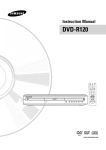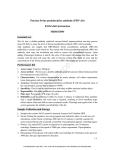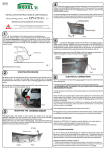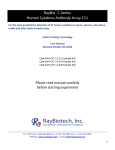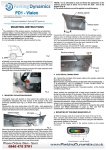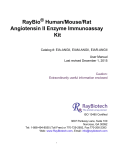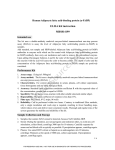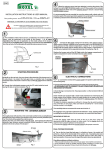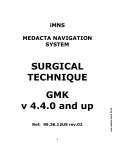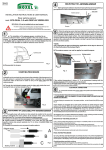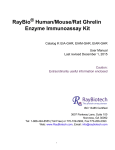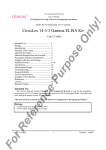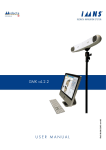Download Human Kininogen ELISA Kit
Transcript
Human Kininogen ELISA Kit Assaypro LLC 3400 Harry S Truman Blvd St. Charles, MO 63301 T (636) 447-9175 F (636) 395-7419 www.assaypro.com For any questions regarding troubleshooting or performing the assay, please contact our support team at [email protected]. Thank you for choosing Assaypro. Symbol Key Consult instructions for use. Assay Summary Add 50 µl of Standard/ Sample per well. Incubate 2 hours. Wash, then add 50 µl of Biotinylated Antibody per well. Incubate 1 hour. Wash, then add 50 µl of SP Conjugate per well. Incubate 30 minutes. Wash, then add 50 µl of Chromogen Substrate per well. Incubate 10 minutes. Add 50 µl of Stop Solution per well. Read at 450 nm immediately. H G F E D C B A 1 2 3 4 5 6 7 8 9 10 11 12 Assay Template AssayMax Human High Molecular-Weight Kininogen ELISA Kit Catalog No. EK1001-1 Sample protocol for reference only Introduction High molecular-weight kininogen (HK) is a plasma protein coagulation cofactor serving for the activation of zymogens prekallikrein, Factor XII, and Factor XI and is also a substrate of each of their proteolytic forms. It circulates as a complex with these zymogens and links the plasma coagulation, fibrinolysis, complement activation, and blood pressure control. HK is produced by the liver and weighs 120 kDa with 626 amino acids. Its plasma concentration ranges from 55 to 90 µg/ml (1-5). HK exhibits anticoagulant properties and is a strong inhibitor of cysteine proteases. Upon cleavage by kallikrein, the released active peptide bradykinin mediates NO release, vasodilation, hypotension, and pain. The remaining cleaved HK (HKa) exhibits antiadhesive and antiangiogenic activity, enhancing cell-associated fibrinolysis and releasing cytokines and chemokines to enhance inflammation. Patients with HK deficiency exhibit abnormal surface-mediated activation of fibrinolysis (6, 7). Principle of the Assay The AssayMax Human Kininogen (HMW) ELISA (Enzyme-Linked Immunosorbent Assay) kit is designed for detection of human kininogen in urine, saliva, milk, CSF, and cell culture samples. This assay employs a quantitative sandwich enzyme immunoassay technique that measures human kininogen in less than 4 hours. A polyclonal antibody specific for human kininogen has been pre-coated onto a 96-well microplate with removable strips. Kininogen in standards and samples is sandwiched by the immobilized antibody and the biotinylated polyclonal antibody specific for kininogen, which is recognized by a streptavidin-peroxidase conjugate. All unbound material is then washed away and a peroxidase enzyme substrate is added. The color development is stopped and the intensity of the color is measured. Caution and Warning Prepare all reagents (working diluent buffer, wash buffer, standard, biotinylated antibody, and SP conjugate) as instructed, prior to running the assay. 1 Prepare all samples prior to running the assay. The dilution factors for the samples are suggested in this protocol. However, the user should determine the optimal dilution factor. Spin down the SP conjugate vial and the biotinylated antibody vial before opening and using contents. This kit is for research use only. The kit should not be used beyond the expiration date. The Stop Solution is an acidic solution. Reagents Human Kininogen Microplate: A 96-well polystyrene microplate (12 strips of 8 wells) coated with a polyclonal antibody against human kininogen. Sealing Tapes: Each kit contains 3 precut, pressure sensitive sealing tapes that can be cut to fit the format of the individual assay. Human Kininogen Standard: Human kininogen in a buffered protein base (200 ng, lyophilized). Biotinylated Human Kininogen Antibody (50x): A 50-fold concentrated biotinylated polyclonal antibody against kininogen (140 l). MIX Diluent Concentrate (10x): A 10-fold concentrated buffered protein base (30 ml). Wash Buffer Concentrate (20x): A 20-fold concentrated buffered surfactant (30 ml, 2 bottles). Streptavidin-Peroxidase Conjugate (SP Conjugate): A 100-fold concentrate (80 l). Chromogen Substrate: A ready-to-use stabilized peroxidase chromogen substrate tetramethylbenzidine (8 ml). Stop Solution: A 0.5 N hydrochloric acid to stop the chromogen substrate reaction (12 ml). Storage Condition 2 Upon arrival, immediately store components of the kit at recommended temperatures up to the expiration date. Store SP Conjugate and Biotinylated Antibody at -20°C. Store Microplate, Diluent Concentrate (10x), Wash Buffer, Stop Solution, and Chromogen Substrate at 2-8°C. Unused microplate wells may be returned to the foil pouch with the desiccant packs and resealed. May be stored for up to 30 days in a vacuum desiccator. Diluent (1x) may be stored for up to 30 days at 2-8°C. Store Standard at 2-8°C before reconstituting with Diluent and at -20°C after reconstituting with Diluent. Other Supplies Required Microplate reader capable of measuring absorbance at 450 nm. Pipettes (1-20 l, 20-200 l, 200-1000 l, and multiple channel). Deionized or distilled reagent grade water. Sample Collection, Preparation and Storage Urine: Collect urine using sample pot. Centrifuge samples at 800 x g for 10 minutes. Dilute samples 1:200 into MIX Diluent and assay. The undiluted samples can be stored at -20°C or below for up to 3 months. Avoid repeated freeze-thaw cycles. Saliva: Collect saliva using sample tube. Centrifuge samples at 800 x g for 10 minutes. Dilute samples 1:20 into MIX Diluent and assay. The undiluted samples can be stored at -20°C or below for up to 3 months. Avoid repeated freeze-thaw cycles. Milk: Collect milk using sample tube. Centrifuge samples at 800 x g for 10 minutes. Dilute samples 1:200 into MIX Diluent and assay. The undiluted samples can be stored at -20°C or below for up to 3 months. Avoid repeated freeze-thaw cycles. Cell Culture Supernatants: Centrifuge cell culture media at 3000 x g for 10 minutes to remove debris. Collect supernatants and assay. Store samples at -20°C or below. Avoid repeated freeze-thaw cycles. CSF: Collect cerebrospinal fluid (CSF) using sample tube. Centrifuge samples at 3000 x g for 10 minutes. Dilute samples 1:50 into MIX Diluent and assay. The undiluted samples can be stored at -80°C for up to 3 months. Avoid repeated freeze-thaw cycles. Reagent Preparation Freshly dilute all reagents and bring all reagents to room temperature before use. MIX Diluent Concentrate (10x): If crystals have formed in the concentrate, mix gently until the crystals have completely dissolved. Dilute the MIX Diluent Concentrate 1:10 with reagent grade water. Store for up to 30 days at 2-8°C. Standard Curve: Reconstitute the 200 ng of Human Kininogen Standard with 2 ml of MIX Diluent to generate a 100 ng/ml standard solution. Allow the standard to sit for 10 minutes with gentle agitation prior to making dilutions. Prepare duplicate or triplicate standard points by serially diluting the standard solution (100 ng/ml) 1:2 with equal volume of MIX Diluent to produce 50, 25, 12.5, 6.25, 3.125, and 1.563 ng/ml solutions. MIX Diluent serves as the zero standard (0 ng/ml). Any remaining solution should be frozen at -20°C and used within 30 days. 3 Standard Point P1 P2 P3 P4 P5 P6 P7 P8 Dilution Standard (100 ng/ml) 1 part P1 + 1 part MIX Diluent 1 part P2 + 1 part MIX Diluent 1 part P3 + 1 part MIX Diluent 1 part P4 + 1 part MIX Diluent 1 part P5 + 1 part MIX Diluent 1 part P6 + 1 part MIX Diluent MIX Diluent [Kininogen] (ng/ml) 100.0 50.00 25.00 12.50 6.250 3.125 1.563 0.000 Biotinylated Human Kininogen Antibody (50x): Spin down the antibody briefly and dilute the desired amount of the antibody 1:50 with MIX Diluent. Any remaining solution should be frozen at -20°C. Wash Buffer Concentrate (20x): If crystals have formed in the concentrate, mix gently until the crystals have completely dissolved. Dilute the Wash Buffer Concentrate 1:20 with reagent grade water. SP Conjugate (100x): Spin down the SP Conjugate briefly and dilute the desired amount of the conjugate 1:100 with MIX Diluent. Any remaining solution should be frozen at -20°C. Assay Procedure 4 Prepare all reagents, standard solutions, and samples as instructed. Bring all reagents to room temperature before use. The assay is performed at room temperature (20-25°C). Remove excess microplate strips from the plate frame and return them immediately to the foil pouch with desiccants inside. Reseal the pouch securely to minimize exposure to water vapor and store in a vacuum desiccator. Add 50 l of Human Kininogen Standard or sample per well. Cover wells with a sealing tape and incubate for 2 hours. Start the timer after the last addition. Wash five times with 200 l of Wash Buffer manually. Invert the plate each time and decant the contents; hit 4-5 times on absorbent material to completely remove the liquid. If using a machine, wash six times with 300 l of Wash Buffer and then invert the plate, decanting the contents; hit 4-5 times on absorbent material to completely remove the liquid. Add 50 l of Biotinylated Human Kininogen Antibody to each well and incubate for 1 hour. Wash the microplate as described above. Add 50 l of Streptavidin-Peroxidase Conjugate to each well and incubate for 30 minutes. Turn on the microplate reader and set up the program in advance. Wash the microplate as described above. Add 50 l of Chromogen Substrate per well and incubate for 10 minutes or till the optimal blue color density develops. Gently tap plate to ensure thorough mixing and break the bubbles in the well with pipette tip. Add 50 l of Stop Solution to each well. The color will change from blue to yellow. Read the absorbance on a microplate reader at a wavelength of 450 nm immediately. If wavelength correction is available, subtract readings at 570 nm from those at 450 nm to correct optical imperfections. Otherwise, read the plate at 450 nm only. Please note that some unstable black particles may be generated at high concentration points after stopping the reaction for about 10 minutes, which will reduce the readings. Data Analysis Calculate the mean value of the duplicate or triplicate readings for each standard and sample. To generate a standard curve, plot the graph using the standard concentrations on the x-axis and the corresponding mean 450 nm absorbance on the y-axis. The best-fit line can be determined by regression analysis using log-log or four-parameter logistic curve-fit. Determine the unknown sample concentration from the Standard Curve and multiply the value by the dilution factor. Standard Curve The curve is provided for illustration only. A standard curve should be generated each time the assay is performed. Human Kininogen Standard Curve OD 450 nm 1.0 0.1 1 10 100 1000 [Kininogen] (ng/ml) 5 Performance Characteristics The minimum detectable dose of kininogen is typically ~ 1.5 ng/ml. Intra-assay and inter-assay coefficients of variation were 4.9% and 7.2% respectively. Linearity Sample Dilution 1:10 1:20 1:40 Average Percentage of Expected Value Saliva 87% 98% 107% Sample Dilution 1:100 1:200 1:400 Average Percentage of Expected Value Urine Milk 87% 91% 99% 98% 103% 104% Recovery Standard Added Value Recovery % Average Recovery % 3.13 – 50 ng/ml 84 – 109% 96% Cross-Reactivity Species Beagle Bovine Monkey Mouse Rat Swine Rabbit Proteins LMW Kininogen HMW Kininogen 6 % Cross Reactivity None None <10% None None None None % Cross Reactivity <50% 100% References (1) (2) (3) (4) (5) (6) (7) Reddigari SR et al. (1993) Blood 81:1306-1311 Maier M et al. (1983) Proc. Natl. Acad. Sci. USA 80:3928-3932 Kellermann J et al. (1986) Eur. J. Biochem. 154:471-478 Kitamura N et al. (1985) J. Biol. Chem. 260:8610-8617 Kerbiriou DM and Griffin JH (1979) J. Biol. Chem. 254:12020-12027 Coffman LG et al. (2009) Proc. Natl. Acad. Sci. USA 106:570-575 Hassan S et al. (2007) Am. J. Physiol Heart Circ Physiol. 292:H2959-H2965 Version 1.5 Related Products EK2001-1 AssayMax Human Kininogen (HMW) ELISA Kit (Plasma and Serum samples) www.assaypro.com • E-mail: [email protected] 7













